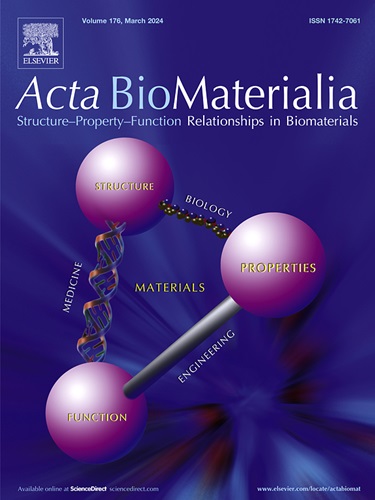Copper-doped layered double hydroxides co-deliver proteins/drugs for cascaded chemodynamic/immunotherapy via dual regulation of tumor metabolism
IF 9.4
1区 医学
Q1 ENGINEERING, BIOMEDICAL
引用次数: 0
Abstract
We report here a Cu2+-doped layered double hydroxide (LDH) nanoplatform to load both monocarboxylate transporter inhibitor diclofenac (DC) and lactate oxidase (LOX) for dual modulation of tumor lactate and redox metabolisms to activate immunotherapy through enhanced Cu-mediated chemodynamic therapy (CDT) of tumors. The formed LDH-DC-LOX nanoparticles with a diameter of 55 nm are stable, can be effectively taken up by cancer cells to regulate lactate through both LOX-mediated catalytic conversion and DC-enabled inhibition of extracellular efflux of lactate, and can exert redox metabolism through CDT via Cu2+-mediated glutathione (GSH) depletion and Fenton-like reaction with hydrogen peroxide (H2O2) that can be further accumulated via LOX-mediated catalysis. The major advantage of the developed LDH-DC-LOX nanoparticles lies in the therapeutic synergy and cascade that can be achieved through the loaded DC and LOX for enhanced tumor lactate metabolism regulation, for enhanced Cu-mediated CDT and redox metabolism regulation, and for activation of immunotherapy that can further enhances the Cu2+-mediated CDT effect. The developed LDH nanoplatform demonstrated here for effective murine breast tumor treatment provides a new paradigm for dual regulation of lactate and redox metabolisms that may enable synergistic and cascaded combination therapy of different cancer types.
Statement of significance
Targeting the tumor microenvironment (TME) to alter tumor metabolic pathways represents a promising strategy for next-generation cancer therapy. Herein, a copper-doped layered double hydroxide (LDH) nanoplatform is developed to co-deliver both diclofenac (DC) and lactate oxidase (LOX) to tumor cells for efficient dual regulation of tumor lactate and redox metabolisms, resulting in synergistic and cascaded chemodynamic therapy/immunotherapy of breast tumors. The developed LDH-DC-LOX nanoparticles can release Cu2+ and DC under an acidic TME, and can act in synergy to reduce TME lactate and generate H2O2, thus modulating redox metabolism and activating anticancer immunotherapy. The secreted cytokine IFN-γ after activation of antitumor immune responses can further mediate enhanced chemodynamic therapy effect through downregulation of cystine/glutamate transporter SLC7A11 to suppress GSH synthesis.

求助全文
约1分钟内获得全文
求助全文
来源期刊

Acta Biomaterialia
工程技术-材料科学:生物材料
CiteScore
16.80
自引率
3.10%
发文量
776
审稿时长
30 days
期刊介绍:
Acta Biomaterialia is a monthly peer-reviewed scientific journal published by Elsevier. The journal was established in January 2005. The editor-in-chief is W.R. Wagner (University of Pittsburgh). The journal covers research in biomaterials science, including the interrelationship of biomaterial structure and function from macroscale to nanoscale. Topical coverage includes biomedical and biocompatible materials.
 求助内容:
求助内容: 应助结果提醒方式:
应助结果提醒方式:


